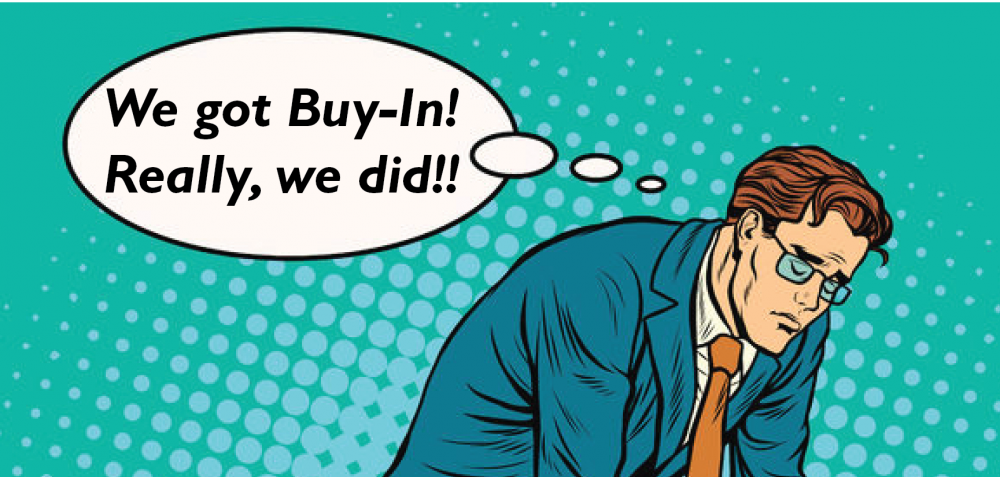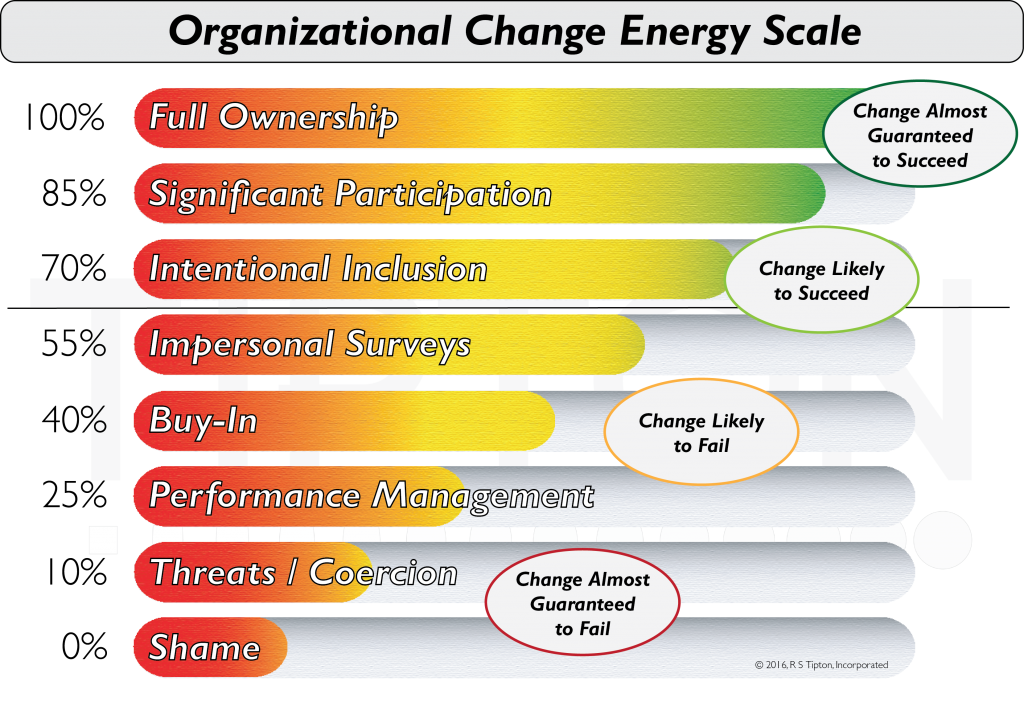
24 Feb Buy-In Sucks. Here’s Why.
(Apologies to all healthy, strong individuals who weigh 98 pounds [or so], it’s just an expression!)
You know the mantra in the upper management wing of most organizations: “Let’s get everyone to buy-in, and then we’ll be successful…” And then, a few weeks or months later, the change doesn’t stick, and people wonder what went wrong. “Buy-In” is virtually powerless to truly drive significant, transformational change. If this is true, why do so many managers think that “Buy-In” is all that’s necessary?
“We got buy-in!” they shout, but the results show they didn’t get success.
 What went wrong?
What went wrong?
Here’s a thought – let’s look at the situation totally differently.
Should you get to know me, you’ll discover I’m a bit of a science geek (just ask my kids about “Dad’s science lesson of the day!). I’m fascinated by how things are connected in the universe and how everything works at various levels.
One thing I’ve come to understand is this: when we get down to the very, very smallest thing in the known universe, it’s this REALLY small unit of energy called a planck (at .00000000000000000000000000000000001 meters – that’s friggin’ small!!).
As such, everything – you, me, Chipotle burritos and Head and Shoulders shampoo, are all made of a LOT of tiny, tiny bits of energy. Everything in the universe, at its most elemental level, is energy, and as such, everything has a level of power, a scale, a frequency if you will. Some energy we can see – like the visible light part of the electromagnetic spectrum. Some energy we can feel – like acceleration in our cars as we try to “beat” the person next to us at a stoplight (what, am I the only one?).
Now, if everything in the universe is made up of energy, so are our decisions, our agreements, our choices. Have you ever considered what “kind” of energy we’re using related to those things? There’s a scale for that too.
Here’s why I say, “Buy-In Sucks…” It’s the wrong energy to seek related to decisions, to agreements, to choices – it’s too powerless.
Let me explain a bit more. Let’s say you’re planning an organizational change – a new computer system, a merger or acquisition, a new branding exercise, a new leader, something – and you want to get the organization to move in a certain direction to adopt the change. That would require some energy, true?
So, what’s the best energy to seek?
Here’s one thing that I’ve discovered in more than thirty years in working in transformational change. If you want to ensure that organizational change works, it’s better to get a higher level of energy to DRIVE the change forward, as opposed to a low level of energy that requires you to constantly pull up.
If we look at different energy frequencies associated with change, let’s say on a scale from zero to a hundred, buy-in is at about 40 (maybe less). It’s a very low level of energy, and the reason is this: “Buy-In” implies that someone else did something, and then they brought it you for you to “maybe want / maybe not want” it. Think about it like advertising – somebody has something they want to sell you – but, you really weren’t part of the process to create “it” in the first place. How many organizational changes happen that way? A small group of “special” people come up with a new idea, and then corporate marketing and communications gets involved to “sell” the idea to everyone else. No wonder the vast majority of organizational changes fail.
What if there was a totally different way to approach the situation – would you be up to learn more about it?
If “Buy-In” is at 40 on the organizational change energetic spectrum, what’s at 80, or 90, or maybe even a 100? The closer we get to 100, the more people will say, “The change was done THROUGH us, not done TO us.” It’s about being part of the process, it’s about having our fingerprints and perspectives contained in the ultimate solution. It’s about owning the answer as the answer is being developed.
To get that to happen, it’s about participation.
Now, unless you really LIKE to constantly drag your organization forward through changes and “hope” for the best (realizing your change is likely to fail), here are three simple ideas related to driving higher levels of organizational change energy:
1. HONOR THOSE AFFECTED:
Have the patience – and the organizational core value – to honor the perspectives of those affected by change. After all, organizations don’t change, people change – one at a time – inside the organization. The more people who are moving in the same direction at the same time the better – and that’s when it only “looks” like organizational change. When people feel honored and respected, much of their inherent resistance to change will dissipate.
2. PAY ATTENTION / LISTEN:
Much of the time change isn’t a democratic process (there’s a mandate from somewhere) – but that doesn’t mean you can’t involve those that are impacted by the change in designing the “way” the change will be implemented and managed. Ask them “how” to make this happen – you’ll likely be amazed at the wealth of great ideas they have. Even if you have had “that idea” yourself already, you still stand to learn something when you hear it presented from their perspective. Listen to them!
3. AUTHENTICALLY ANSWER QUESTIONS:
Ask those in your organization – on a regular basis – for feedback related to their understanding about the what, why, when, how and who associated with the change. Even shame or threat-based approaches to change will let people know the “what” – however, without the “why” most people are left unsatisfied when it comes to the rationale and purpose for the change. It’s then when they will remain reticent to truly get behind the change. Answer their questions!
So – all the way back to the title of this post. Buy-In Sucks, and Here’s Why. Buy-In is completely the wrong energy to fuel sustainable, significant organizational change. It’s too low on the energetic scale.
Instead, if you find yourself asking this question on a regular basis, “How will this actually work in your area?” – as long as you act upon the answers you hear – you’ve moved up on the scale of organizational change energy. It’s at that point that your organization will begin to feel a sense of ownership, of authentic participation, and a belief that change is being done through them, not being done to them.
Are you up for trying something else? I’ll bet your results will be significantly better – if you bring a higher level of energy. Give it a shot!
For more information about how to ENSURE change will fail, read my blog on the “Top 10 Ways to Ensure Epic Organizational Change Failures.”




No Comments